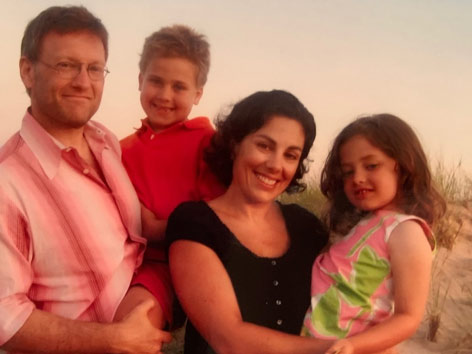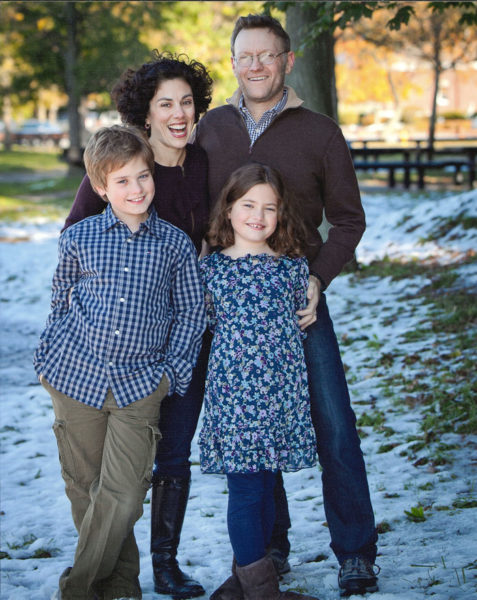Amy and Amid never imagined that melanoma could be so deadly. At first, the cancer seemed curable, but then it quickly progressed, and Amid lost his battle. Today, Amy honors the life of her beloved late husband by educating her Health magazine readers about skin cancer prevention and early detection. Her hope is that one day, no family will have to experience the heartache that her family suffered. Amy joined the movement to save lives and she hopes you will, too.
By AMY CONWAY, Editor-in-Chief, Health magazine
Just Another Mole
It’s painful to admit how naive we were.
Sure, I had seen the articles, the public service ads, the signs in doctors’ offices showing the ABCDEs of melanoma. So I knew that a mole that changes needs to be checked out. And indeed, every morning when we would be getting dressed for work, wrangling our two kids, ages 6 and 8, and trying to make the morning train into Manhattan, I would see the mole on my husband’s abdomen that had just started to darken.
I would tell him, “You need to get that checked out.”
“I know, I know,” he would say. So we knew, but we didn’t know. Amid had had a skin check a few months earlier, and anyway, don’t they just remove the mole and you’re OK? Skin cancer is totally curable, right?
Alarm Bells: The Need to Get Checked
When Amid called his dermatologist’s office to have the mole checked out, the scheduler explained that they couldn’t see him for several weeks. Unsatisfied with that response, he contacted our primary care doctor’s office and they weren’t able to fit him in either. More days were passing, and I was getting nervous. I called my own dermatologist, and her office said to come right in.
She removed the mole immediately, sent it for a biopsy and before we knew it, referred Amid to an oncological surgeon, who scheduled an operation right away. We knew he had melanoma, but we didn’t yet know what that really meant.

Amy, Amid, and their two children before Amid’s melanoma spread.
The surgeon removed more tissue surrounding the area where the mole had been removed on Amid’s abdomen, as well lymph nodes to see if the cancer had spread. The surgery revealed some minor lymph node involvement, and while I assumed that would mean treatments like chemo and radiation, the doctors explained those were not their recommendation for melanoma. Instead, they would simply watch Amid closely and do frequent scans.
Things went back to normal — Amid didn’t feel or seem sick, and we didn’t spread the word that he had cancer because it didn’t feel like he did. Life was good. That was 2010.
A Year of Monitoring
The scans came back clean for about a year, at which point his doctors found some “spots” on his liver. Just cut them out, I suggested helpfully to his wonderful team at Memorial Sloan Kettering Cancer Center in New York City. “It doesn’t work that way,” they said. “There will just be more, and more.” I was in shock, not expecting that answer, but thought surely there were other options to try.
By that fall of 2011, exciting advances were being made in immunotherapy — treatments that supercharge your own immune system to fight the cancer, the doctors explained. I was reading articles in The New York Times about some very sick melanoma patients having amazing recoveries. Why couldn’t Amid be one of them? He was accepted into a drug trial and also tried another medicine that had just been approved. Then the doctors put him on both of these brand-new drugs at the same time. He was one of the first patients to be on this combination. It all seemed so cutting-edge and promising that it just had to work.

Amy, Amid and their two children, ages eight and ten, four months before Amid passed away.
Not Enough Time
While many melanoma patients on combinations of immunotherapies respond well to the drugs, they don’t work for everyone. My husband was one of the unlucky ones. About six months after the first bad scan, Amid passed away.
Just a few days before, I had been trying to tell him everything that I knew I wouldn’t be able to say for much longer, to sum up what he meant to me. He shushed me and said simply, “It’s been perfect.” He was talking about his life, the whole thing — a happy childhood, good friends, a career he was passionate about, a beautiful marriage and family of his own. It was perfect. Just way too short.
Out of Tragedy Comes Hope
The story continues — our children, now 16 and 18 are becoming amazing young adults, and I know their dad would be so proud of them. I have many wonderful people in my life and am grateful for so much.
One thing I’m thankful for is the opportunity to share our experience and spread awareness about skin cancer. As the editor-in-chief of Health magazine, I am able to reach our readers with crucial information about practicing sun safety, getting skin checks, and knowing what to look for on their bodies.
I am proud to share the message of The Skin Cancer Foundation to reach families and individuals who may never have thought that skin cancer could affect them, even though one in five people will develop skin cancer by the age of 70. There is still much to be done to find a cure, and much that can be done to prevent and detect this disease. Join the movement to invest in the prevention, early detection and treatment of skin cancer. It was too late for my husband when his skin cancer was detected, but it does not have to be for your loved ones and friends.
Join the Movement: Donate Today!
[Editor’s note: Since Amid passed away, there have been further breakthrough drug approvals and intense research to study how new combinations of immunotherapies may save the lives of more melanoma patients. Learn more in this interview with Nobel laureate James P. Allison, PhD.]





